
(date of birth unknown)
Chief Kokomo, whose name is also sometimes given as Koh-Koh-Mah, Co-come-wah, Ma-Ko-Ko-Mo, or Kokomoko, was a Native American man of the Miami tribe who lived in northern Indiana at some point probably in the early nineteenth century. He owned a log cabin in the Center Township of Howard County, which was later turned into a trading post. The city of Kokomo is named after him.

The Miami natives originally lived in Indiana, Illinois, and southern Michigan at the time of European colonization of North America. They soon became the most powerful American Indian tribe in Ohio.
The Miami were allies of the French until British traders moved into the Ohio Country, around 1740. As French trading posts turned into British forts, many Miami natives moved to present-day Indiana to avoid further battles with the more powerful British. During the American Revolution, the Miami, allied with the British to prevent further expansion of the United States.
General Anthony Wayne defeated the Miami at the Battle of Fallen Timbers in 1794. The Miami were forced to surrender most of their Ohio lands. In 1818, the United States forced the Miami to give up their last reservation in Ohio. Many of the displaced Ohio Miami settled in Indiana, but, once more, the U.S. Federal Government removed some of them to Kansas during the 1850s, while others were permitted to remain in Indiana.
- From Miami Indians, Ohio History Central

(1773-1847)
Frances was captured by the Delaware after her family was attacked in 1778, when she was five years old. She was given to a childless Delaware chief and his wife. They named her Weletasash, after their youngest daughter who had died, and raised her as their own. She migrated with the Delaware and settled near present-day Fort Wayne. She married She-pan-can-ah, a Miami warrior, around 1794. She-pan-can-ah was a Miami warrior who later became a Miami chief. When Frances joined the Miami, she took the name Maconaquah (Little Bear). She was eventually reunited with her surviving siblings, but lived out the rest of her life with the Miami.
- Indiana Historical Society, Hoosiers and the American Story

(1781-1879)
Chief Meshingomesia was a prominent figure in the War of 1812. He was the son of Miami Chief Metocinyah. This tribe of the Miami Indians was chronicled in history by engaging in the first major battle of the War of 1812 in Grant County, Indiana. The Mississinewa Battlefield was the site of the first victory of the United States Army during the War of 1812, on December 17-18, 1812. A 600-man mounted force led by Lt. Col. John B. Campbell attacked and destroyed four British-allied Indian villages led by Chief Meshingomesia.
The war took its toll on the American forces, and the traditional Miami land was deeded to Chief Meshingomesia and the Miami by the United States in the Treaty of 1840. Chief Meshingomesia was honored for his willingness to partner with the United States Government after the conflict. He founded the historic Miami Indian Village schoolhouse, and the land was passed on to his heirs, who lost the property to US manipulation of property tax laws.
- Chief Meshingomesia - Miami Indian Cemetery, Waymarking.com
- The Meshingomesia Cemetry, Miami Nation of Indians of the State of Indiana
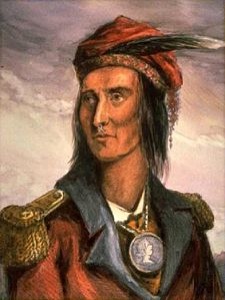
(1768?–1813)
A chief of the Shawnee. When the United States refused to recognize his principle that all Native American land was the common possession of all the Native Americans, Tecumseh set out to bind together the Native Americans of the Old Northwest, the South, and the eastern Mississippi valley. His plan failed with the defeat of his brother, the Shawnee Prophet, at Tippecanoe (1811). In the War of 1812, Tecumseh allied himself with the British and was made a brigadier general. He led a large force of Native Americans in the siege of Fort Meigs, and lost his life in the battle of the Thames, in which Gen. William Henry Harrison overwhelmed Procter and his Native American allies. Tecumseh had great ability as an organizer and a leader and is considered one of the outstanding Native Americans in American history.

(1775?–1836)
Tenskwatawa was given the name Lalawethika, or "The Noise Maker", when he was born. He was Tecumseh's little brother, but he did not receive a warrior's education, and was famously bad at hunting. He was an alcoholic for many years, until he had a vision during a near-death experience, that he should unite the Native American tribes and take back their land from the Europeans. He was renamed Tenskwatawa, meaning the “The Open Door” or “One With Open Mouth.” He was frequently referred to as "The Prophet." Tenskwatawa founded the Pan-Indian Federation on the banks of the Tippecanoe River in Prophetstown, Indiana, until the town was attacked and destroyed by William Henry Harrison's army in 1811.
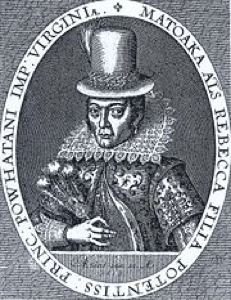
(c.1595–1617)
According to the famous story, Pocahontas saved the life of the captured Capt. John Smith just as he was about to have his head smashed at the direction of Powhatan. In 1613, Pocahontas was captured by Capt. Samuel Argall, taken to Jamestown, and held as a hostage for English prisoners then in the hands of her father. At Jamestown she was converted to Christianity and baptized as Rebecca. John Rolfe married her in Apr., 1614. The union brought peace with the Native Americans for eight years. With her husband, Pocahontas went to England in 1616. There she was received as a princess and presented to the king and queen. She started back to America in 1617 but was taken ill and died at Gravesend, where she was buried. Pocahontas bore one son, Thomas Rolfe, who was educated in England, went (1640) to Virginia, and gained considerable wealth.

(?-1622)
An interpreter for the Wampanoag chief, Massasoit, he became known as a friend of the Pilgrims, teaching them how to plant corn and where to fish. He was born into the Pawtuxet group near Plymouth, Massachusetts. He was taken from New England by English fishermen to be sold as a slave in Spain, but escaped to England, and made his way back to America (1619). Because the Pawtuxets had been wiped out by disease, he joined the Wampanoags, whom he helped to conclude a peace treaty with the Pilgrims.
- Chambers Biographical Dictionary, Biography Reference Bank
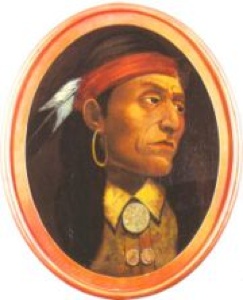
(1720-1769)
Ottawa Indian chief. Pontiac's efforts to unite tribes in the Great Lakes area in order to maintain Indian control of the region during the French and Indian War resulted in what is known as Pontiac's Rebellion. In 1763 Pontiac attacked all British forts on the Great Lakes. Although he captured eight of the twelve posts, the rebellion was unsuccessful because the French failed to send reinforcements. Pontiac's Rebellion prompted King George III to issue the Proclamation of 1763, forbidding white settlers to move west of the Appalachian Mountains. In 1769 Pontiac visited Cahokia, Illinois, where a young Peoria warrior killed him after being bribed by a British trader.
- Great American History Fact Finder, Biography Reference Bank
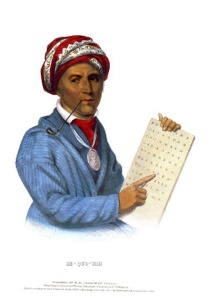
(1767-1843)
Native American scholar. Born in Tennessee, he was probably the son of an English trader but was raised by his Cherokee mother. He invented a Cherokee syllabary of 85 characters in 1826. He taught thousands of Cherokee to read and write and served as a political envoy for his people. His name was given to a genus of giant coniferous trees (Sequoia) and to a national park.
- Chambers Biographical Dictionary, Biography Reference Bank.
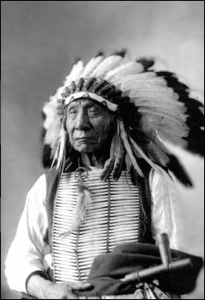
1821/1822 - 1909
He led the Native American fight against the establishment of the Bozeman Trail in what became known as “Red Cloud's War” (1866–68). The government finally abandoned the trail and the forts built to protect it (1868). After signing a treaty he lived in peace with the whites, although he was later charged with duplicity in encouraging hostile Native Americans.
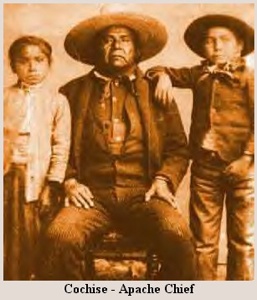
(?-1874)
Chiricahua Apache chief who led the resistance to white incursions into the American Southwest. Nothing is known of his birth or early life. In 1861 skirmishes and eventually all-out war broke out between the Apache and the U.S. Army. Cochise and his followers eluded capture for 10 years. By 1872, however, most Apache, including Cochise, had agreed to move onto reservations.
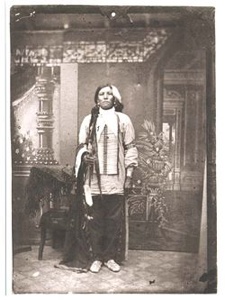
(1840–1877)
Chief of the Oglala tribe of the Sioux Indians. Joining ranks with Sitting Bull, Crazy Horse led his forces over Gen. George Crook at the Battle of the Rosebud on June 17, 1866. They then surrounded Col. George Armstrong Custer at the Little Bighorn River in Montana, resulting in the death of Custer and all his men in what became popularly known as “Custer's Last Stand.” Crazy Horse was pursued by Col. Nelson Miles and surrendered in Nebraska on September 5. He was stabbed to death when he resisted being locked up in a guardhouse after his arrest.
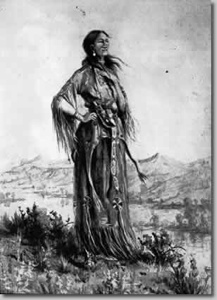
(1788-1812?)
Native North American woman who accompanied the Lewis and Clark expedition, the only woman in the party. She is generally called the Bird Woman in English, although this translation has been challenged. She apparently was a member of the Shoshone, had been captured in a Hidatsa raid and enslaved, and finally was traded to French-Canadian fur trader Toussaint Charbonneau, who referred to her as one of his wives. He was engaged as an interpreter for the expedition, and she proved invaluable as a guide and interpreter when Lewis and Clark reached the upper Missouri River and the mountains from which she had come. On the return journey she and Charbonneau left (1806) the expedition at the Hidatsa-Mandan villages.

(1829 - 1909)
Chief of the Apache nation. Geronimo led attacks during the Apache War (1871–76) against settlers in Arizona. Noted for his bravery and fierceness, he finally surrendered to Gen. Nelson Miles in 1886. He and his followers were exiled to Florida and later to Fort Sill in Indian Territory (now Oklahoma) where he became a successful farmer and a tourist attraction at fairs and exhibitions.
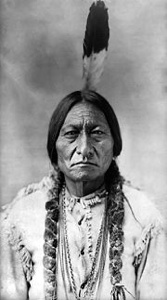
(1831-1890)
A Teton Sioux chief under whom the Sioux peoples united in their struggle for survival. Frequent skirmishes between the U.S. Army and Sitting Bull’s warriors occurred in 1863–68, at the end of which the Sioux agreed to accept a reservation in southwestern Dakota Territory. When gold was discovered in the Black Hills in the mid-1870s, further outbreaks occurred. In 1877 Sitting Bull led his followers into Canada, but, with the buffalo reduced to near extinction, starvation drove the Sioux to surrender. From 1883 Sitting Bull lived on Indian Agency lands, at one point (1885) traveling with Buffalo Bill’s Wild West Show. During the Ghost Dance movement, Sitting Bull was arrested. He was killed when his warriors tried to rescue him.
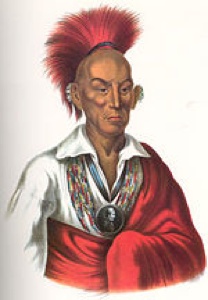
(1767 - 1838)
Sauk Indian chief. Black Hawk struggled determinedly against the westward movement of the white settlers. During the War of 1812 he aided the British against the Americans. In 1831 he led his tribes into Illinois to reclaim their homeland, leading to the Black Hawk War. Captured in 1832, Black Hawk was released to a reservation the following year. In 1833 he wrote his autobiography, a classic statement of Indian resentment of white settlers.

(1840?-1904)
Chief of Nez Perce tribe. When gold was discovered in Oregon in the 1870s, the U.S. government appropriated a large part of the Nez Perce reservation in the area without the consent of the Indians whose land it was. When strife ensued over settlers intruding on the land, the tribe decided to flee to Canada. Eluding the pursuing U.S. Army with whom they engaged in skirmishes during the summer of 1877, they reached Bear Paw, Montana, forty miles south of the Canadian border, on September 23 and stopped to rest. But Gen. Nelson Miles and the U.S. Cavalry overtook them and forced their surrender on October 5. He and his tribe were exiled to Indian Territory (present-day Oklahoma) and later were sent to Colville Reservation in Washington, where Joseph died and was buried.

(1868-1939)
Luther Standing Bear was the chief of the Lakota Sioux from 1905 until his death in 1939. During his leadership of the Lakota people he worked ceaselessly to improve conditions on the reservation and restore a sense of pride to his people. He wrote four books about Indian life and the connection of that life to the natural world, including My People The Sioux, My Indian Boyhood, Land of the Spotted Eagle, and Stories of the Sioux. He was an educator of his people and strove to enlighten white people about the way of the Lakota.

(1945– 2010)
Wilma Mankiller worked for several years as a leading advocate for the Cherokee people and became the first woman to serve as their principal chief in 1985. She sought to improve the nation’s health care, education system, and government. She decided not to seek re-election in 1995 due to ill health. After leaving office, Mankiller remained an activist for Native American and women's rights until her death in 2010. Recently, a US quarter has been minted with her image.
- Encyclopedia of the American Indian in the Twentieth Century, Credo Reference